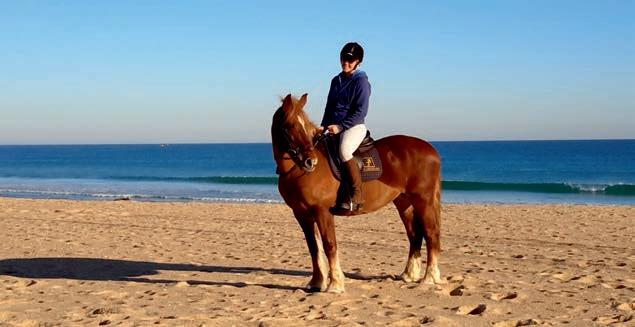
4 minute read
Outside reads
THIS MONTH, WHILE DAWN TAKES A REST, KEEN GARDENERS WILL BE HEADING FOR THE MEDITERRANEAN GARDEN FAIR, AT SILVES ’
FISSUL EXHIBITION HALL, 25-26 MARCH, TO SEE WHAT SPECIALIST GROWERS HAVE ON OFFER. ROSIE PEDDLE , SECRETARY OF THE MGAP, LISTS HER FAVOURITE GARDENING BOOKS
PLANTING IN A POST-WILD WORLD: DESIGNING PLANT COMMUNITIES FOR RESILIENT LANDSCAPES
By Thomas Rainer and Claudia West
Publisher: Timber Press, 2015
This ground-breaking guide, which is fully illustrated with examples from inspiring gardens, presents a powerful alternative to traditional horticulture by showing us designed plantings that function like naturally occurring plant communities. The authors are two leading voices in current ecological garden design, and they reveal how plants fit together in nature and how we can use this knowledge to create resilient, beautiful and diverse gardens and landscapes.
MEDITERRANEAN KITCHEN GARDEN: GROWING ORGANIC FRUIT AND VEGETABLES IN A HOT, DRY CLIMATE
By Mariano Bueno
Publisher: Frances Lincoln, 2010

This is highly recommended for those interested in fruit and vegetable growing in our challenging climate. The book is not easy to find, but worth the effort on an online search. Mariano Bueno is Spain’s leading organic gardener and gives full practical details on how to grow vegetables alongside fruit trees and a variety of aromatic, medicinal and ornamental plants and herbs. He covers seasonal work calendars, seed saving and pests and diseases.
Planting Design For Dry Gardens
By Olivier Filippi
Publisher: Filbert Press, 2016
Beautiful, resilient groundcovers for terraces, paved areas, gravel and other alternatives to the lawn – excellent, thorough and inspirational. In this second of his three masterworks on dry gardens, pioneering nurseryman Olivier Filippi from southwest France proposes a selection of lowmaintenance groundcover plantings that are so beautiful they might just consign lawns to history. The quality of this book puts it head and shoulders above any other, offering advice on lawn removal and alternative planting.
Topics covered in detail include the creation of green carpets than can be walked on for high traffic areas, low level aromatic plants and bulbs for those areas less frequented, and ground cover perennials and shrubs for larger areas. Gravel gardens, pavements and threshing floors can also be planted to provide colour and yearround interest. Each zone is discussed, illustrated with high-quality images and has specific plant list recommendations. It is recommended for anyone who wishes to reduce their watering demands and rediscover the pleasure a flourishing dry garden can bring. Throw off the tyranny of the lawn and embrace diversity and beauty in your garden by creating a ‘freedom lawn’.
To see the full range of books available from MGAP online bookshop in English, French and Portuguese, visit mgaportugal.org/ BooksGB.html
ALGARVE WILDLIFE – THE NATURAL YEAR
By Clive Viney and Ray Tipper
Publisher: First Nature, 2016

This superbly illustrated, authoritative wildlife diary is written and produced by local experts drawing on decades of meticulous observation, and provide detailed guidance on what to see and where. A hardback, it is lavishly illustrated with some 600 colour photographs of birds, butterflies, mammals, reptiles, wildflowers and scenic views of the Algarve countryside, together with a map, directions and descriptions of the Algarve’s top locations for wildlife and scenic walks. Packed with a wealth of information, fascinating facts for Algarve visitors and residents alike, it is written in clear language accessible to all readers, without losing the scientific accuracy sought by botanists, birdwatchers and other nature-lovers.
Field Guide To The Wild Flowers Of The Algarve
By Chris Thorogood and Simon Hiscock
Publisher: Kew Publishing, 2014
This is the revised second edition of the first comprehensive identification guide to the rich Mediterranean flora of the Algarve region of southern Portugal, including the Cape St. Vincent National Park, an area of immense botanical importance with numerous endemic and rare species. Information is provided on where and when to see plants with information on their habitat and vegetation types. With over 1,000 species descriptions, the book is abundantly illustrated throughout with over 650 stunning colour photographs, 780 line drawings and distribution maps.
Mediterranean Landscape Design
By Louisa Jones
Publisher: Thames and Hudson, 2012
This book includes hundreds of wonderful photographs by Clive Nichols. Drawing on 30 years of exploration by Louisa Jones, this book offers a fresh vision of the Mediterranean, linking gardens, landscape design, literature, art and architecture. It presents work from throughout the region, whether a lushly layered property in the Tuscan countryside or a Zen-inspired plot on the French island of Corsica.
The Land Where Lemons Grow
By Helena Attlee
Publisher: Penguin, 2015
This fascinating book covers many subjects including travel, history, botany, economics, the inevitable recipes and of course, oranges and lemons. Travellers have always been thrilled by the sight of citrus in Italy, where dark leaves and bright fruit seem to charge the landscape, making the trees symbols of a sun-soaked, poetic vision of the country.
Citrus also holds a special place in the Italian imagination, and Helena Attlee sets out to explore its curious past and its enduring resonance in Italian culture. She maps the citron’s long migration from the foothills of the Himalayas to the shores of southern Italy, traces the bitter juice of Seville oranges through ancient Roman and Renaissance cookery books, exposes early manifestations of the Mafia during the nineteenth-century citrus boom, and laments the loss of landscapes shaped by citrus cultivation.
THE WELL GARDENED MIND: REDISCOVERING NATURE IN THE MODERN WORLD
By Sue Stuart-Smith
Publisher: William Collins, 2020
A powerful combination of contemporary neuroscience, psychoanalysis and compelling real life stories shows us the remarkable effects of nature on our health and wellbeing. It covers the science of the brain’s own ‘gardener’ cells to the grounding effects of working with nature’s rhythms of growth, decay and regeneration, proving that the garden is a vital place to cultivate the mind.













